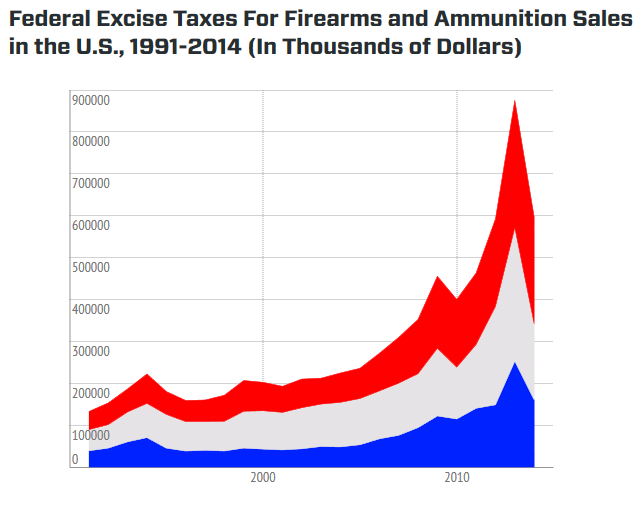Math Arguments
Problems, Questions, and Puzzles to spark discussion and argument in the maths classroom.
NY Daily Statistics
NY Daily News had this:
Government-hating gun owners are shooting themselves in the foot.
The gun-buying frenzy triggered by the 2012 Sandy Hook school shooting pumped $875 million into federal coffers in 2013 alone, according to Vocativ.com. That's because the Treasury's Alcohol and Tobacco Tax and Trade Bureau collects a 10% tax on ammo sales and a nearly 10% tax on gun sales. The tax revenue on guns and ammo reached an all-time high the year after the Sandy Hook Elementary School massacre, which left 27 students and teachers dead and triggered fears of stricter gun laws.
The roughly $255 million in tax revenue on ammunition alone brought in by the feds in 2013 was nearly double the 1991 tax receipts for handguns, long guns and ammo combined, according to Vocativ.

Graphicacy:
Graphicacy is the ability to read or create a visual (usually in graph form); the visual must communicate well with the reader. Generally, if it takes the reader more than a few seconds to figure out what's going on, it's a bad diagram or graph.
INTERPRET THE VISUAL. What is it saying? What point is it trying to make?
Is this visual distorted or misleading? Could quick interpretations of it jump to wrong conclusions? If so, what incorrect conclusions might be drawn? How is it communicating badly: what normal assumptions and expectations does this graph contradict? What errors did the creator make?
Would you change or fix the graph? If so, how would you change it? Do you think this visual was drawn this way on purpose, or is this a mistake or just a matter of incompetence? Is this the best type of graph/visual for this data?
source.
Graphicacy (a variation of the words "Literacy" and "Numeracy") means the ability to read and understand the visual representation of data and ideas. Most commonly, we are interpreting bar charts, pie charts, scatterplots and other data representations, but the rise in the use of infographics has meant that Math teachers must teach this new literacy.
The second aspect of graphicacy is the identification and correction of bad graphics that push a distorted interpretation of the data. Often for political purposes, the promotion of deliberately incorrect or distorted graphs can be damaging to the country, to democracy, or to the health and well-being of the reader. In the words of Mark Twain, "There are three ways to lie. Lies, Damned Lies, and Statistics."
The quintessential Bad Graph: Gun Deaths in Florida
 ++
++